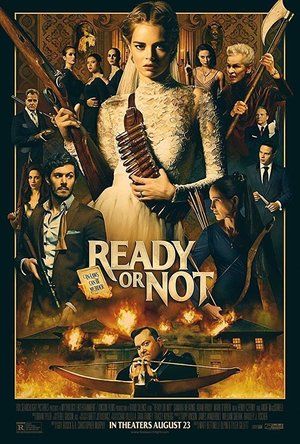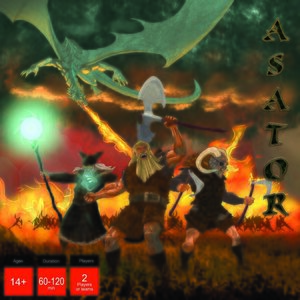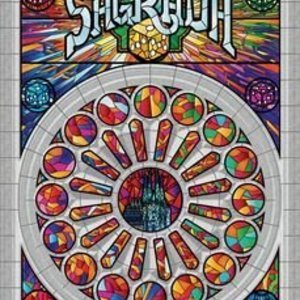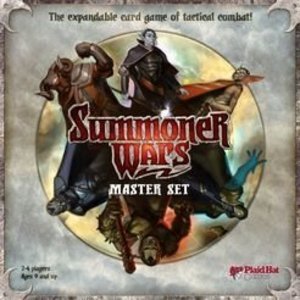
Summoner Wars: Master Set
Tabletop Game
Summoner Wars is a fast-playing, action-packed card game for 2-4 players in which they take on the...

Yu-Gi-Oh! arc-V
TV Show
Thanks to the Leo Corporation, headed by Reiji Akaba, new advancements to Solid Vision, the...
JT (287 KP) rated Ready or Not (2019) in Movies
Mar 3, 2020
After a long sweeping shot through a gothic house 30-years earlier which sets up the back story to what is going to unfold, Grace is tasked with drawing a card from a mysterious mechanical box.
The premise is simple, whatever game is on the card she has to play in order to be accepted into the family – a tradition which must be accepted.
Innocently believing that it is just a harmless game of Hide-and-Seek Grace sets off to hide. The family, however, arming themselves with a variety of antique weaponry, must kill poor Grace before sunrise or they will all perish.
The family is an eclectic mix of batshit crazed parents, eccentric grandparents, troublesome daughters and drunken sons. When merged they come across as a psychopath’s answer to the Keystone Cops, all flair but no clue whatsoever.
Ready or Not manages to balance horror and comedy nicely. It is gory when it needs to be with several grotesque and humorous scenes that will leave viewers squirming in their seats.
The remainder of the film is a tense game of cat and mouse with Grace now realising what the real motives of the family are. She must hold her nerve to see out the night and make it to morning.
The setting is perfect for this type of caper and the gothic mansion provides plenty of twists and turns; from secret doors and passages to outhouses filled with decaying corpses.
Grace turns from the bride in white to the bride in blood as she battles the family – the tension rarely lets up for a second. Ready or Not gets just about everything spot on and it never suffers from horror cliches or boredom.
Weaving gives a good account of herself as a modern-day scream queen turned badass, running around in a torn wedding dress and trainers dispelling the myth ‘till death do us part‘.
Purple Phoenix Games (2266 KP) rated Faza in Tabletop Games
Oct 28, 2020
Faza is a sci-fi, grid movement, modular board, purely cooperative board game for one to four players. In this review I will be addressing it from a solo player’s viewpoint. In my plays I have used the full complement of four characters and controlled them all simultaneously.
In Faza, players take on the roles of four Faction Zeta members tasked with saving Earth from the Faza alien race. They will accomplish this by using each character’s skills effectively and efficiently, killing alien drones invading the town tiles, and attacking motherships using the help of turncoat rebel Faza. Only one path to victory lies ahead with several ways to lose. Do you got the GUTS? DO YA??
DISCLAIMER: We were provided a copy of this game for the purposes of this review. This is a retail copy of the game, so what you see in these photos is exactly what would be received in your box. I do not intend to cover every single rule included in the rulebook, but will describe the overall game flow and major rule set so that our readers may get a sense of how the game plays. For more in depth rules, you may purchase a copy online or from your FLGS. -T
To setup a game of Faza, each player will choose a character to control throughout the game. These characters are medical, political, tactical, or technological in nature, and there are two of each from which players may choose. The map of the town is comprised of 16 tiles, and once randomly setup in a 4×4 grid players will place their color-matched meeples on the appropriate Outpost tiles along with two rebels (purple fazeeples). Each of the three mothership standees will be placed on tiles corresponding to rulebook placement along with three drones and two drones per orthogonally adjacent tiles. The Faza deck is to be shuffled and placed aside, along with the remaining drones and rebels. Each player places out their character action cards in numerical order and the game may now begin in earnest!
On a player’s turn… well, there aren’t any turns in this game. In fact, the game is played over several phases: the Team Phase and the Faza Phase. During the Team Phase players may use several free actions and one action pertaining to each of their four player action cards. Each of these cards offer the player a choice of two actions. Perhaps one side is movement and the other a bazooka. Or one is an airplane while the other is a raygun, for example. As actions are spent cards are twisted 90 degrees to keep track.
During the Team Phase players may play their actions in any order that would benefit the team best. This also includes fighting drones and sending rebels to damage the motherships. However, with every damage to the mothership taken a Faza card is drawn and put into play. These could be real bad news for the heroes, or even reward cards. They can be devastating or not so bad at all. Once players have finished the Team Phase, the action now turns to the Faza.
During the Faza Phase the Mothership Activation Tracker will move to the next mothership in sequence and activate their abilities. The motherships will typically move, do something bad to the terrain or drop more drones or destroy something, and then pass play onto the players again.
Each mothership starts the game with 4 HP and once players send enough rebels and encounter the same number of Faza cards the mothership is downed and less powerful when their ability card is activated. However, players will win once all three motherships have been defeated! On the other hand, players will lose when any one player dies of injuries from unsuccessful battles, the players run out of drones to be placed on the board when needed, all of the Outpost tiles have been terraformed by the Faza motherships, or all rebels have been removed from the board in Hard Mode.
Components. When contacted about reviewing the game I first turned to the website and watched a how to play video by Jon Gets Games. He did a great job explaining the rules clearly and succinctly. Then I happened to get a notification on BGG that Marco Arnaudo posted a video on Faza, so I watched it as well. In his video he complains that though the components are all very nice (which they are for sure) the color palette is not great. I can certainly see why he would say such a thing, but orange is my favorite color, so to see so much of it on a game is a big plus for me. Yes, having the orange drones sitting atop an orange town tile can maybe make for unpleasant color contrast, I happen to find it tolerable and enjoyable. The quality of the components is wonderful and the box has a nice heft to it. No complaints from ME about the components. Did I mention the rebels are an amazing purple color as well? No secret here that we love the color purple! Maybe even more than Oprah!
The gameplay is where it’s at for me. Marco too. We both love this little gem! The ability to sandbox your entire turn and just have one character do one action, then switch over to another character to do one or more actions, then back to the original is just so much fun. Each character has a special ability and four action cards. Even when an injury must be sustained, actions are still available, but at a much lesser potency. That’s a great way to negatively affect the players without having to completely debilitate them. To sustain an injury the player will flip their lowest-numbered action card to the back side, and once all four of their action cards are injured they are dead. D-E-D dead.
As a solo game Faza really delivers the goods. Being able to control two to four characters by oneself and determine the best order to activate abilities and move meeples around is delicious. Having certain tiles offer combat bonuses to matching characters is excellent and a great way to thin the herd of pesky drones. I really cannot say enough great things about the game. If you have never heard of this one, please don’t worry. I really hadn’t either until the designer contacted me about reviewing it. And I am certainly glad he did because this is a marvel of a game. I am looking forward to my next play against the Faza and increasing the difficulty to really bash my confidence on this one.
If you are looking for a game that is relatively quick to play and offers so many great choices, while using a wonderful art style and color palette, I urge you to check out Faza by visiting the website and ordering your copy right away. The Earth needs you to ward off the invaders and you need to play this game of mostly orange with a dash of purple.
Purple Phoenix Games (2266 KP) rated Asator in Tabletop Games
Oct 20, 2020
Asator is a head to head (or teams) game of troop maneuvering and attacking using 30 identical miniatures on each side. Each mini acts as a platoon of three different kinds of armies, plus a Chieftan, Master, Wizard, and Dragon that all have different special abilities. The winner of Asator is the player who can eliminate their opponent’s leadership (Chieftan, Master, and Wizard).
DISCLAIMER: We were provided a prototype copy of this game for the purposes of this review. These are preview copy components, and I know that the final components will be slightly different from these shown. Also, it is not my intention to detail every rule in the game, as there are just too many. You are invited to download the rulebook, back the game through the Kickstarter campaign, or through any retailers stocking it after fulfillment. -T
To setup, place the battle mat on the table, and then players will place groups of minis on the field within the closest three rows of hexes in alternating turn fashion. Players will also take the two large Battle Sheets and a dry-erase marker to keep track of every one of their minis’ stats throughout the game. Each player will also choose five of the given 10 Wizard spell cards to use for the game, and each spell may only be used once during the game. Once all army minis are placed, the first player will move up to 20 units on the battlefield and attack opponent armies if possible. The game is now on and decimation is the goal.
Each mini type corresponds to a different group of armies, plus the dragon and three leader pieces. All armies of the same type have the same stats for movement, hit points (HP), armor rating (AR), and attack weapons. Also each mini is labeled on the bottom so keeping track of each unit is made a little easier. Obviously the leader pieces are more powerful and each has a special style of combat. The Master wields an axe and shield (which is broken after one hit) to increase AR and dole out the damage. The Chieftan wields a spear, twin axes, a bow, and a shield. Similar to the Master, the Chieftan’s shield is broken after an attack against him, and his spear is broken after a missed attack. The Wizard is not at all strong in melee, but has powerful spells at his disposal to be used for the disposal of enemy units.
Besides the leadership trio each side also brings a Dragon to the battle. Dragons can move slowly by land, but quite quickly by air. Once in the air he or she may deliver a Fire Blast that causes huge damage, but then the Dragon must ground themselves to regain stamina for flight. In addition, each player will have access to Cavalry, Infantry, and Bowmen, each with their own stat blocks and abilities.
This is all well and good, and is somewhat similar to the strategy one would use in Chess. Combat, however, is much more involved than that of simply moving into an enemy’s space and automatically overtaking it. In Asator combat victory is decided via a VERY pared down version of D&D combat. It uses a simplified d20-based attack versus the enemy Armor Rating (AR). Rolls over the AR of the enemy is a success and damage is dealt. Done. Some attacks require a roll of 2d6 for damage amount, like spells and Dragon attacks. That said, combat is decided using 1d20 and 2d6. That’s it.
The game continues in turns where the first player will move their pieces and attack, and then the next player will do the same until one player has defeated all three enemy leaders and earned the title of Asator – Master of War.
Components. Again, we were provided a prototype copy of the game, but most of the components are what will be received when the game is backed or purchased. That said, the game utilizes a cloth battle mat that folds into the box, four dry-erase Battle Sheets, two dry-erase markers, dice for both players, Wizard spell cards for both players, and 60 miniatures. The battle mat is great fabric quality with minimal art that doesn’t get in the way of play (much appreciated). The dry-erase components are good. The card quality is fine. The dice are black and white dice to correspond with players using the black or white minis, and are of normal quality. The minis are great and I enjoyed playing with them.
Now for the negatives of what is included in the box. First, the art. Now, there is very minimal art used throughout the game. It’s just not a focal point, and it shows in the game’s production. I found the sketch on the cover of the rule book (which is the same as the watermark on the Battle Mat) to be very cool, but the box cover art leaves some to be desired. Similarly, the Wizard spell cards use very generic-looking art icons with text for explanation. I am most certainly being hyper-critical here because flashy art on these components are certainly not needed to play or highly enjoy the game. For my tastes, though, I would like to see more polished art on these pieces as the art is so sparse throughout.
But how does the game feel? It’s truly quite good. I don’t play many wargames or 1v1 skirmish style games, so to present me with something like this and for me to enjoy it as much as I have has to be a sign of something good. Again, I am no strategic war general, but being able to employ different strategies every game is exciting. Testing out the different combinations of Wizard spell cards is fun for a tinkerer. And, of course, playing with a bunch of minis is always good fun.
There is a good game here, and I absolutely love the combination of Chess maneuverability with the simplified RPG d20 battle system. It works well in a game like this where each piece owns a stat block of which players will need to be mindful. I didn’t quite mention my favorite part of the rules yet either: natural 20 on a combat roll equals insta-death. Yes, even to the Dragon, which happened in my very first game. THAT is a cool rule that tripped up tactics quite often in my plays.
All in all this game is a great example of combining a couple sets of mechanics that wouldn’t be expected and creating a great gaming experience from them. I invite you to back the game on Kickstarter when it goes live if you are looking for that special game that is unlike many others you currently own. If the art were spruced up a bit I would be fawning all over it, but even without impressive art I still find I have the twitch in my brain to play it again and again. I wonder how many natural 20s I can roll in a game. Great, now I want to set it up and see…
Purple Phoenix Games (2266 KP) rated Sagrada in Tabletop Games
Jun 12, 2019
In Sagrada, you are an artist who has been tasked with creating a beautiful stained glass window. Working piece by piece, you build a masterpiece – the likes of which have never before been witnessed. Finding the perfect pieces can be tricky, but through careful use of your tools and with your artistic vision, you can create the best window in the town! The game is played over 10 rounds in which players draft dice and place them in their windows, following certain placement restrictions. A set number of tools are available for use, and can aid you in manipulating the dice to your benefit. Points are scored based on successful completion of private and public objectives, and the player with the highest score at the end of 10 drafting rounds is the winner!
My favorite part about playing Sagrada solo is that the game is essentially played the same way, regardless of player count. The only difference is how you win! In both group and solo play, each player will draft two dice every round. In group play, any leftover dice are discarded, while in solo play, the remaining two dice will be added towards the Target Score – the score you are trying to beat at the end of the game! To find the Target Score, you add all of the die values of your unused dice from each round. If, at the end of the 10 rounds, you have earned more points than the Target Score, you win! But if the Target Score is higher than your final score, you lose.
The game play differences are simple enough, but actually winning the game solo is a different story. I have played Sagrada solo quite a bit, and have won maybe 25% of the time. Depending on which window card and objectives are in play, and because of placement restrictions, I often have to sacrifice high-valued dice to the Target Score. And since there are no placement restrictions for the Target Score, and two dice are added to it each round, it is very easy for that score to sky-rocket. I either barely pull off a win, or I lose by a huge margin. Playing in a group is nicer in this regard because the other players have the same placement restrictions that I have – nobody is just getting points for free. Without the Target Score, there really is no way to play Sagrada solo, but it makes the game feel a little imbalanced to me.
Just because it is difficult to win solo does not mean that I do not like the game. It requires quite a bit of strategy, and that keeps me engaged for the entire game. There are dice placement restrictions based on color AND value, so there are two different ways in which you have to constantly be strategizing. You can’t just focus on either value or color – your strategy must always be changing based on which color dice are drawn and what values are subsequently rolled. Even with the amount of strategy required, Sagrada actually plays pretty quickly as a solo game, and I really like that. I like the challenge of this game, and often try to play until I can win. Since I can finish an entire solo game in probably 10-15 minutes, I am able to get multiple plays in a row!
Sagrada is a challenging game to play solo, but not in a way that feels futile. I don’t win a lot, but the strategic implications and the pretty dice colors are what keep me coming back to this game! If you haven’t tried Sagrada solo yet, I’d encourage you to give it a shot. But be warned – you might not always win.
https://purplephoenixgames.wordpress.com/2019/02/26/solo-chronicles-sagrada/

Jurassic World™: The Game
Games and Entertainment
App
Return to Isla Nublar with the creators of the smash hit Jurassic Park™ Builder for your next...

Disney Magic Kingdoms
Games and Entertainment
App
WELCOME TO THE MOST MAGICAL PLACE ON MOBILE! When Maleficent casts an evil spell on the Kingdom,...

A Man Walks on to a Pitch: Stories from a Life in Football
Book
'When a man walks on to a pitch there's always a chance something magic can happen, that's what...
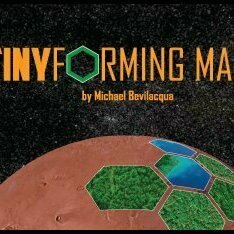
TINYforming Mars
Tabletop Game
TINYforming Mars is a 1-2 player game set in the distant future when mankind has mastered the...
